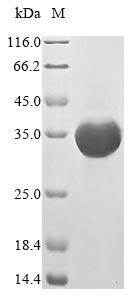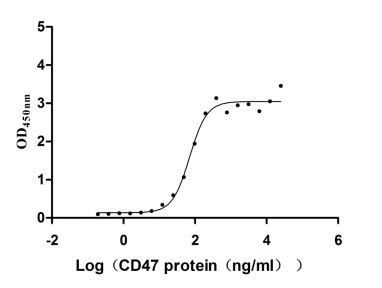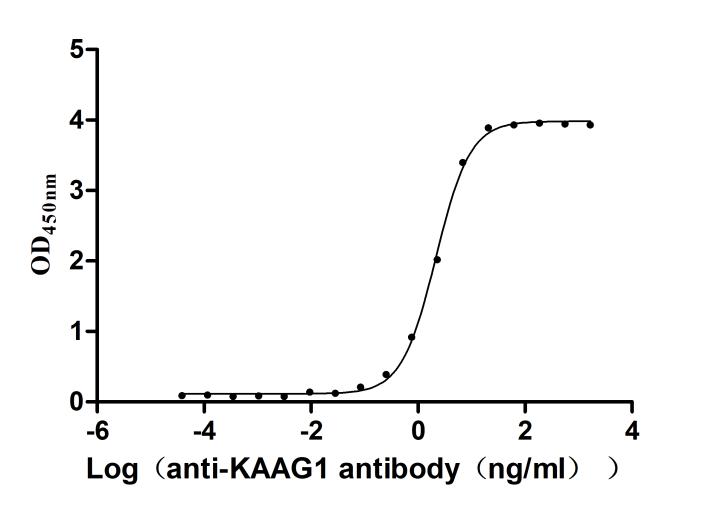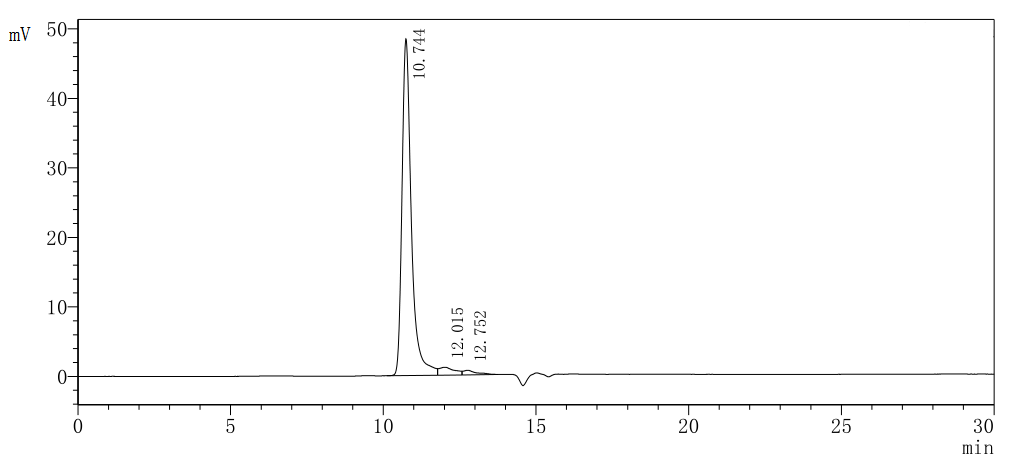Recombinant Mouse Formyl peptide receptor 2 (Fpr2), partial
In Stock Promotion-
货号:CSB-EP008855MO1
-
规格:¥2328
-
促销:

-
图片:
-
其他:
产品详情
-
纯度:Greater than 85% as determined by SDS-PAGE.
-
基因名:
-
Uniprot No.:
-
别名:Fpr2; Fpr-rs2; Formyl peptide receptor 2; Formylpeptide receptor-related sequence 2; Lipoxin A4 receptor-like protein; N-formylpeptide receptor-like 2
-
种属:Mus musculus (Mouse)
-
蛋白长度:Partial
-
来源:E.coli
-
分子量:33.3 kDa
-
表达区域:1-29aa
-
氨基酸序列MESNYSIHLNGSEVVVYDSTISRVLWILS
Note: The complete sequence including tag sequence, target protein sequence and linker sequence could be provided upon request. -
蛋白标签:N-terminal 10xHis-GST-tagged and C-terminal Myc-tagged
-
产品提供形式:Liquid or Lyophilized powder
Note: We will preferentially ship the format that we have in stock, however, if you have any special requirement for the format, please remark your requirement when placing the order, we will prepare according to your demand. -
缓冲液:Tris-based buffer,50% glycerol
-
储存条件:Store at -20°C/-80°C upon receipt, aliquoting is necessary for mutiple use. Avoid repeated freeze-thaw cycles.
-
保质期:The shelf life is related to many factors, storage state, buffer ingredients, storage temperature and the stability of the protein itself.
Generally, the shelf life of liquid form is 6 months at -20°C/-80°C. The shelf life of lyophilized form is 12 months at -20°C/-80°C. -
货期:3-7 business days
-
注意事项:Repeated freezing and thawing is not recommended. Store working aliquots at 4°C for up to one week.
-
产品描述:
The expression vector recombined with the recombinant DNA was transformed into the E.coli for expression. The recombinant DNA resulted from the fusion of the gene coding for the 1-29aa of the mouse Fpr2 protein and the N-terminal 10xHis-GST tag and C-terminal Myc tag gene. The product was purified and isolated to get the recombinant mouse Fpr2 protein with N-terminal 10xHis-GST tag and C-terminal Myc tag. This recombinant Fpr2 protein's purity reaches up to 85%. Under SDS-PAGE condition, this recombinant Fpr2 protein showed a band with a molecular weight of about 30-40 kDa on the gel.
Fpr2 is a gene encoding an enzyme named formyl peptide receptor 2(abbreviated Fpr2) and belongs to G-protein coupled receptor 1 family located on the surface of many cell types of various animal species. The formyl peptide receptors (FPRs) play an important functional role in host defense and inflammation by regulating the activation of phagocytes. Fpr2 is primarily expressed in neutrophils and not detected in vomeronasal neurons. An increasing body of evidence suggests that FPR2 plays a key role in immune resolution. It has been reported that FPR2 is activated by various ligands, such as pro-resolving eicosanoids (lipoxins and resolvins), and a synthetic hexapeptide, Trp-Lys-Tyr-Met-Val-D-Met-NH2 (WKYMVm).
-
Datasheet & COA:Please contact us to get it.
相关产品
靶点详情
-
功能:High affinity receptor for N-formyl-methionyl peptides (FMLP), which are powerful neutrophil chemotactic factors. Stimulates chemotaxis in immune cells to site of infection or tissue damage upon recognition of several ligands, such as FMLP, or ligand involved in cell damage, disease or inflammation. Receptor for the chemokine-like protein FAM19A5, mediating FAM19A5-stimulated macrophage chemotaxis and the inhibitory effect on TNFSF11/RANKL-induced osteoclast differentiation.
-
基因功能参考文献:
- virus infection with enterovirus 71 and H1N1 PR8 influenza virus results in increased FPR2 expression. Inhibition of STAT3 phosphorylation in virus-infected cells repressed the induction of FPR2, which led to a reduction in viral loads. PMID: 29127186
- this study shows that formyl peptide receptor activation inhibits the expansion of effector T cells and synovial fibroblasts and attenuates joint injury in models of rheumatoid arthritis PMID: 29879657
- The influx of leukocytes into the peritoneum of WT and mFpr2(-/-) mice was analyzed. We demonstrate that mFpr2 is specifically activated by phenol-soluble modulin (PSM) peptides, and they represent the first secreted pathogen-derived ligands for the mFpr2. PMID: 28855276
- Study showed significantly increased expression of FPR1 and FPR2, during differentiation of neural stem cells (NSCs). The activation of FPRs promotes NSCs to differentiate into neurons with more primary neurites and branch points and longer neurites per cell. Meanwhile, this activation also inhibits the differentiation of NSCs into astrocytes. PMID: 28303030
- activation of Fpr2 in bone marrow after WKYMVm treatment provides cardiac protection through mobilization of circulating angiogenic cells after myocardial infarction. PMID: 27790799
- we suggest that Fpr2-mediated signaling in follicular dendritic cells plays a key role in germinal center maintenance in Peyer's patches PMID: 27974458
- FAM3D plays a role in gastrointestinal homeostasis and inflammation through its receptors FPR1 and FPR2. PMID: 26966188
- antagonist pretreatment or gene silencing of the RvD1 receptor, ALX/FPR2, abrogated the anti-inflammatory and pro-resolving actions of RvD1. These data indicate that RvD1 ameliorates IR-induced liver injury, and this protection is associated with enhancement of M2 polarization and efferocytosis via ALX/FPR2 activation PMID: 27317426
- a novel FPR2 agonist, the proteolytically stable alpha-peptide/beta-peptoid hybrid Lau-((S)-Aoc)-(Lys-betaNphe)6-NH2 (F2M2), showing comparable potency in activating human and mouse neutrophils by inducing a rise in intracellular Ca(2+) concentration and assembly of the superoxide-generating NADPH oxidase. PMID: 27422818
- We conclude that ANX-A1 is an important regulator of mast cell reactivity to compound 48/80 exerting a negative feedback effect through a mechanism that depends at least partly on the FPR receptor PMID: 26803520
- annexin A1- formyl peptide receptor 2 pathway mediated the insulin resistance of skeletal muscle, as well as systemic insulin sensitivity. PMID: 25616869
- Deficiency of formyl peptide receptor 2 is associated with increased inflammation and enhanced liver injury after LPS-stimulation PMID: 24956481
- AnxA1 and Fpr2 have a critical role in the manifestation of adrenal insufficiency in this LPS-induced model, through regulation of cholesterol ester storage PMID: 25818588
- Ldlr(-/-)xFpr2(-/-) mice exhibited delayed atherosclerosis development and less macrophage infiltration compared with Ldlr(-/-)xFpr2(+/+) mice. PMID: 25341894
- Compared with wild-type mice, Fpr2/3(-/-) animals exhibited exacerbation of disease severity, including hypothermia and cardiac dysfunction. PMID: 25512512
- Fpr1/2 are critical for normal healing of the sterile skin wound by mediating the first wave of neutrophil infiltration. PMID: 24603667
- FPR1 and FPR2 play an important role in the innate immune responses against Streptococcus pneumoniae within the central nervous system and the lack of the receptors leads to a dysregulation of the inflammatory response compared with wild-type mice. PMID: 24863484
- Oxidized low-density lipoprotein stimulates macrophages, resulting in chemotactic migration, TNF-alpha production, and foam cell formation via FPR2 signaling. PMID: 24361884
- During ischemia, neutrophil Fpr2/3 controls platelet/neutrophil aggregates with the rapid generation of circulating LXA4, which in turn modulates downstream vascular inflammatory responses evident during the reperfusion phase. PMID: 23733341
- FPR2 is not activated by lipoxin (LX)A; the molecular mechanism by which LXA functions still needs to be identified. PMID: 23643932
- Fpr2 mediated foam cell formation PMID: 23500463
- FPR2 is critical in mediating homeostasis, inflammation, and epithelial repair processes in the colon. PMID: 23454745
- Results indicate that the AnxA1/FPR2 system has an important role in effecting the resolution of cerebral inflammation in sepsis and may provide a novel therapeutic target. PMID: 22964301
- The mechanism involved impaired early neutrophil recruitment to the liver with Fpr2 being sole receptor for neutrophils to sense Listeria chemoattractant signals and for production of bactericidal superoxide. PMID: 23139859
- These results suggest that Fpr2 plays an important role in host defense against implanted LLC by sustaining macrophages in an M1 phenotype with more potent antitumor activities. PMID: 23139214
- results suggest that microvascular endothelial cells express mFPR2 which can be upregulated by proinflammatory factors IL-1beta and LPS through JNK and NF-kappaB related signaling pathways PMID: 21761148
- The conclusions drawn from these experiments are that neither compound 43 nor LXA4 works as FPR2 agonists in neutrophils, findings of importance for a proper interpretation of results obtained with these compounds as regulators of inflammation. PMID: 21535079
- The recognition of Abeta by the formylpeptide chemotactic receptor 2 seems to be a starting point of the signaling cascade inducing an inflammatory state in AD. PMID: 20456016
- Studies show that inflammation was more marked in Fpr2(-/-) mice. PMID: 20107188
- This study reveals a critical role for mFPR2 in the progression of allergic airway inflammation and immune responses. PMID: 20200280
- By selectively up-regulating FPR2 in microglia, TNF alpha has the capacity to amplify host response in inflammatory diseases in the central nervous system. PMID: 12270697
- TLR9 may play an important role in promoting microglial recognition of Abeta42 by up-regulating the expression of the G-protein- coupled receptor mFPR2 PMID: 16219804
- mouse neutrophils, which like macrophages and dendritic cells express Fpr2, responded to human and mouse F2L in both calcium flux and chemotaxis assays PMID: 17237393
- the effect of IFN-g and its synergy with CD40L on mFPR2 expression in microglia was mediated in part by TNF-alpha; IFN-g and CD40L may profoundly affect microglial cell responses in the pathogenic process in which mFPR2 agonist peptides are elevated PMID: 17237425
- IL-10 may affect the pathogenic process of Alzheimer's disease by up-regulating mFPR2 and thus favoring the recognition and internalization of Abeta(42) by activated microglial cells PMID: 17544285
- TLR2 and NOD2 cooperate to up-regulate the expression of mFPR2 and therefore, may actively participate in the pathogenic processes of brain inflammation and neurodegenerative diseases. PMID: 18299458
- (Poly(I:C)), which is a specific TLR3 ligand, and Imiquimod (R837), which is a specific TLR7 ligand, when used alone, each increased MAPK-dependent functional mFPR2 expression in microglial cells. PMID: 19559490
显示更多
收起更多
-
亚细胞定位:Cell membrane; Multi-pass membrane protein.
-
蛋白家族:G-protein coupled receptor 1 family
-
组织特异性:Primarily expressed in neutrophils. Not detected in vomeronasal neurons.
-
数据库链接:
KEGG: mmu:14289
STRING: 10090.ENSMUSP00000065799
UniGene: Mm.378918
Most popular with customers
-
Express system: Mammalian cell
Species: Homo sapiens (Human)
-
Recombinant Human V-set and immunoglobulin domain-containing protein 4 (VSIG4), partial (Active)
Express system: Mammalian cell
Species: Homo sapiens (Human)
-
Recombinant Human Claudin-6 (CLDN6)-VLPs, Fluorescent (Active)
Express system: Mammalian cell
Species: Homo sapiens (Human)
-
Recombinant Human Interleukin-2 receptor subunit alpha (IL2RA), partial (Active)
Express system: Mammalian cell
Species: Homo sapiens (Human)
-
-
Recombinant Human Kidney-associated antigen 1(KAAG1) (Active)
Express system: E.coli
Species: Homo sapiens (Human)
-
Express system: Mammalian cell
Species: Homo sapiens (Human)
-
Recombinant DT3C (Diphtheria toxin & spg 3C domain) for Antibody Internalization Assay
Express system: E.coli
Species: Corynephage beta





f4-AC1.jpg)















